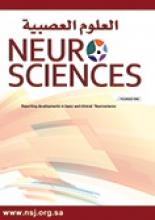Article Figures & Data
Tables
Characteristics n (%) Gender Male 50 (61) Female 32 (39) Types of seizures Generalized 21 (25.6) Focal seizures 33 (40.2) Spasms 12 (14.6) Mixed seizures 16 (19.5) Intractability Yes 45 (54.9) No 37 (45.1) - Table 2
Number of antiepileptic drugs (AEDs) prescribed per patient, number of newer generation AEDs used*, and level of seizure control achieved in patients at enrollment and at the end of one-year follow-up (N=82).
Variables At the start of follow-up, n (%) At the end of follow-up, n (%) Number of AEDs prescribed to control seizures One AED 0 (0) 3 (3.7) 2 AEDs 54 (65.9) 44 (53.7) 3 AEDs 23 (28.0) 26 (31.7) 4 AEDS 5 (6.1) 9 (11) Number of newer generation AEDs prescribed per patient None 28 (34.1) 28 (34.1) One AED 40 (48.8) 34 (41.5) 2 AEDs 13 (15.9) 20 (24.4) 3 AEDs 1 (1.2) 0 (0) Level of seizure control (%) <25% 13 (15.9) 12 (14.6) 25<50% 4 (4.9) 6 (7.3) 50<75% 11 (13.4) 15 (18.3) 75<100 21 (25.6) 20 (24.4) 100% 33 (40.2) 29 (35.4) ↵* When classifying AEDs, the following criteria were used: AEDs that were in clinical use before 1993 were considered to be older generation antiepileptic drugs, which include carbamazepine, phenytoin phenobarbital, ethosuximide, primidone, clonazepam, and valproic acid. While, AEDs approved for clinical use after 1993 were considered newer-generation drugs, including tiagabine, felbamate, gabapentin, oxcarbazepine, zonisamide, lamotrigine, topiramate, and levetiracetam16
- Table 3
Frequency of adverse drug reactions reported by patients (82) and/or patient’ caregivers during follow-up visits.
Type of adverse drug reaction n (%)* Nervousness and irritability 43 (52.4) Reduced appetite 19 (23.1) Sedation 16 (19.5) Weight gain 16 (19.5) Hyperactivity 15 (18.3) Anxiety 6 (7.3) Behavioral change 6 (7.3) Hyperthermia 6 (7.3) Somnolence 6 (7.3) Gait problems 2 (2.4) Insomnia 2 (2.4) Memory loss 2 (2.4) Rash 2 (2.4) Weight loss 2 (2.4) ↵* The following adverse drug reactions were reported by only one patient: cognitive impairment, constipation, drooling, increased appetite, increased blood pressure, increased heart rate, psychomotor slowing,shortness of breath, tremor, and urinary incontinence. Some patients reported more than one adverse drug reaction at a time
- Table 4
Average doses (mg) of antiepileptic drugs used in pediatric patients (82) at the beginning and end of the one year follow-up.
Drug Name Frequency (n) Average Doses (Mean±SD) Min-Maximum Dose Start End Start End Start End Valproic Acid 57 54 567.5±342.7 626.4±420.9 200-2000 100-2000 Levetiracetam 34 30 795.6±479.8 893.3±548.2 150-2000 150-2000 Carbamazepine 30 30 330.7±160.1 364.7±197.1 120-700 40-800 Clonazepam 24 2 1.1±1.2 1.7±3.6 0.2-6 0.1-20 Topiramate 23 23 86.4±54.2 71.7±52.3 25-200 12.5-200 Phenobarbital 16 10 46.0±27.1 46.5±18.0 15-90 15-75 Lamotrigine 8 10 128.1±71.3 113.8±95.5 25-225 25-300 Vigabatrin 7 8 517.9±292.5 703.1±312.9 125-1000 125-1000 Oxcarbazepine 1 1 720±0 720±0 720-720 720-720






